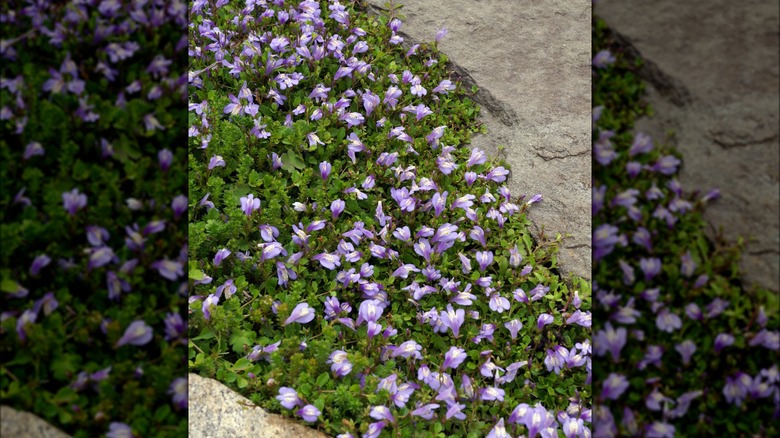This Colorful Flower Is The Ultimate Ground Cover Plant For Suppressing Weeds
Weeds personify the classic archetype of "give me an inch, and I'll take the whole acre." In short, they're an absolute killjoy that loves ruining our landscapes while coercing us into looking for the least harmful ways to kill them (can't afford to harm the adjoining shrubbery, now can we?). However, an easier method to rebuff the weedy advances is to plant groundcovers, like Creeping Mazus (Mazus Miquelii).
Horticulturally sold as "Mazus reptans," these creepers are a woodland gardener's favorite since they're a picturesque fit between stepping stones, pavers, and trails. However, their fast-growing, sideways-spreading nature makes them just as good of a ground-hugger, capable of outwitting weeds. To boot, they bloom showy, symmetrical, two-lipped, lavender corollas (flowers) all spring-summer long, sometimes freckled with a sun-lit yellow. Their slender, hairless, 1-inch-long, velvety green blades remain verdant throughout the year in warmer climates or until fall in cooler zones, requiring little mowing. Reaching about 2 inches in height, Mazus plants are impervious to foot traffic, pests, and diseases, making them a perfect low-maintenance, grass-free alternative for creating an eye-catching front lawn.
Growing and caring for creeping mazus
Indigenous to the Himalayan highlands, creeping mazus plants were introduced by a nursery to the U.S. in the 1990s and resultantly naturalized in USDA zones 5 to 8. However, they perform better in milder winters and wetter summers. These semi-evergreen perennials adore the sun, requiring more than six hours of direct exposure, but will cower for shade when it gets too hot in the afternoon. However, these ground cover plants can adapt to partial shade unless used as understory vegetation for tall trees, including conifers and walnuts, where they're unlikely to thrive. Instead, they're better off paired as overstories for tubers like lilies, whose roots prefer sun protection while setting off a phase of successive blooming.
Creeping mazus plants tolerate most soils, including wet. But if planted around a pond feature, it's best to maintain a 5 to 10 centimeters distance from its edge, as they aren't fond of constantly submerged feet. Extending between 6 and 12 inches wide through their stolons (creeping stems), it's easy to fill a square yard of garden space with six plants. The best part, though? You can divide them every few years in the spring to get new plants (yay!).

